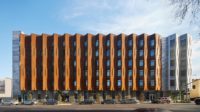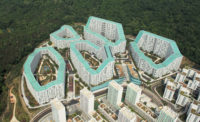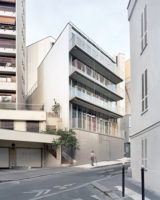Seoul
Although they used repetitive units and simple construction in their Songpa Micro Housing in Seoul, Jinhee Park and John Hong of Single Speed Design (SsD) brought variety and style to the 5,500-square-foot project by animating the spaces in between and around the tiny apartments. Wrapped within a striking container of stainless-steel louvers and enhanced with outdoor and shared spaces, the eight residences subvert the monotonous forms of most micro housing. By design—and ultimately by the client's changes to that design—the project shows that this building type can play a flexible role in a city's mix of housing.
SsD stacked six stories of 120-square-foot boxes, pushing some forward and others to one side to create narrow balconies on the roofs of the units below. Picture Tejo Remy’s Chest of Drawers for Droog, not your grandmother’s credenza. The cement-panel boxes were constructed on-site using two sets of dimensions to add variety and were then placed within a structural steel frame. The stainless-steel scrim around the dwelling units presents a unified front to the street while providing privacy to outdoor decks, and hiding messy gas pipes. Eight variations in the bending of the steel give the screen a flowing rhythm.
The units themselves are tiny, but SsD designed built-in furniture—including Murphy beds and pullout tables—to give them a bit more space and a unified aesthetic. These interiors were prefabricated and then installed in only two days. (Park began her career as an industrial designer and brought her experience to the task.) A claustrophile will find comfort in the walk-in-closet-sized space, with its neat white doors and drawers, while a claustrophobe will appreciate design strategies that open up the space. For example, clerestory windows run the perimeter of each apartment, creating the effect of a floating ceiling. In addition, private decks and small porches offer some breathing room. Wide hallways, furnished with ottomans, provide light-filled communal areas. The outdoor spaces have the added benefit of not being included in the gross floor area calculation, so the building could be a bit bigger. And the corridors are not counted toward parking requirements, so a welcoming entry plaza replaces the more typical ground-floor parking lot.
The project, which replaced a four-story multiuse structure, stands on a quiet block lined with brick and concrete residential buildings in Seoul’s Songpa District. The district has little of the style of the nearby Gangnam neighborhood. Instead of Gucci and galleries, Songpa is characterized by apartment buildings and light commercial structures.
In South Korea, young people have traditionally lived with their parents until they marry, so neighborhoods offer mostly multi-bedroom apartments. But Korean society is changing. According to government figures, population growth in the country has declined from 16.32 percent in 1960 to 1.53 percent in 2010. One- and two-person households accounted for 48.1 percent of the housing market in 2010 and are projected to increase to 68.3 percent in 2035. Micro housing that can serve this population has some precedents in Korean society, including goshiwon (short-term one-room sleep and study spaces for students); goshitel, oneroomtel, or livingtel (longer-term rental apartments); and officetel (buildings that combine studio apartments with work spaces). Park says developers have recently rushed in to build micro housing, taking advantage of new low-interest construction loans designated for doshihyung saenghwal jutek (urban living housing) for one- or two-person households.
SsD notes that the design of its Songpa building differentiates it from other micro-housing projects. “We pushed the client to do something more interesting,” Park says. The clients—members of a local family headed by Chanill Lee, who owns several hospitals and has an interest in art— were receptive. They had visited SsD’s White Block Gallery and agreed with Park and Hong that an innovative design could attract a creative clientele and better compete against projects by big developers. The size of the Songpa units, smaller than Seoul’s more typical 200- to 300-square-foot micro housing, also makes them more affordable.
As the project progressed, the original plans changed, and half of the floors were redesigned for the Lees’ own use: a basement meant to be a work studio for resident artists was built as a café and toy store, second-floor units were converted into an art gallery, and the fourth floor was remade into an apartment for the family’s daughter. In addition, some of the 120-square-foot micro units were combined into 240-square-foot one-bedroom apartments. This means that only five of the planned 16 micro units were built. Yet the modules proved adaptable to changes in the program.
With the new mix of units and uses, it is unclear if the building will produce the kinds of social interaction that SsD had originally planned—such as residents congregating in the wide corridors and talking to each other from various bridges and balconies. But the innovative scheme should attract a design- focused clientele. In a perfect ending, the society they choose to make there will be as creative as the building that contains it.
People
Owner:
Architect:
Personnel in architect's firm who should receive special credit:
Architect of Record:
Engineers:
Consultant(s):
Acoustical:
Other:
General contractor:
Photographer(s): Construction cost: $1.5 million Size: 5,500 square feet Completion date: June 2014 |
Products
Structural system
Exterior cladding
Metal/glass curtain wall:
Curtain wall:
Other cladding unique to this project:
Windows
Entrances:
Metal doors:
Sliding doors:
Fire-control doors, security grilles:
Upswinging doors, other:
Hardware
Closers:
Pulls:
Security devices:
Other special hardware:
Interior finishes
Suspension grid:
Demountable partitions:
Cabinetwork and custom woodwork:
Paints and stains:
Special surfacing:
Floor and wall tile:
Resilient flooring:
Special interior finishes unique to this project:
Furnishings
Reception furniture:
Built-in furniture:
Chairs:
Tables:
Lighting
Downlights:
Task lighting:
Exterior:
Dimming System or other lighting controls:
Conveyance
Plumbing
Toilet:
Accessories:
Energy
Other unique products that contribute to sustainability: |






















